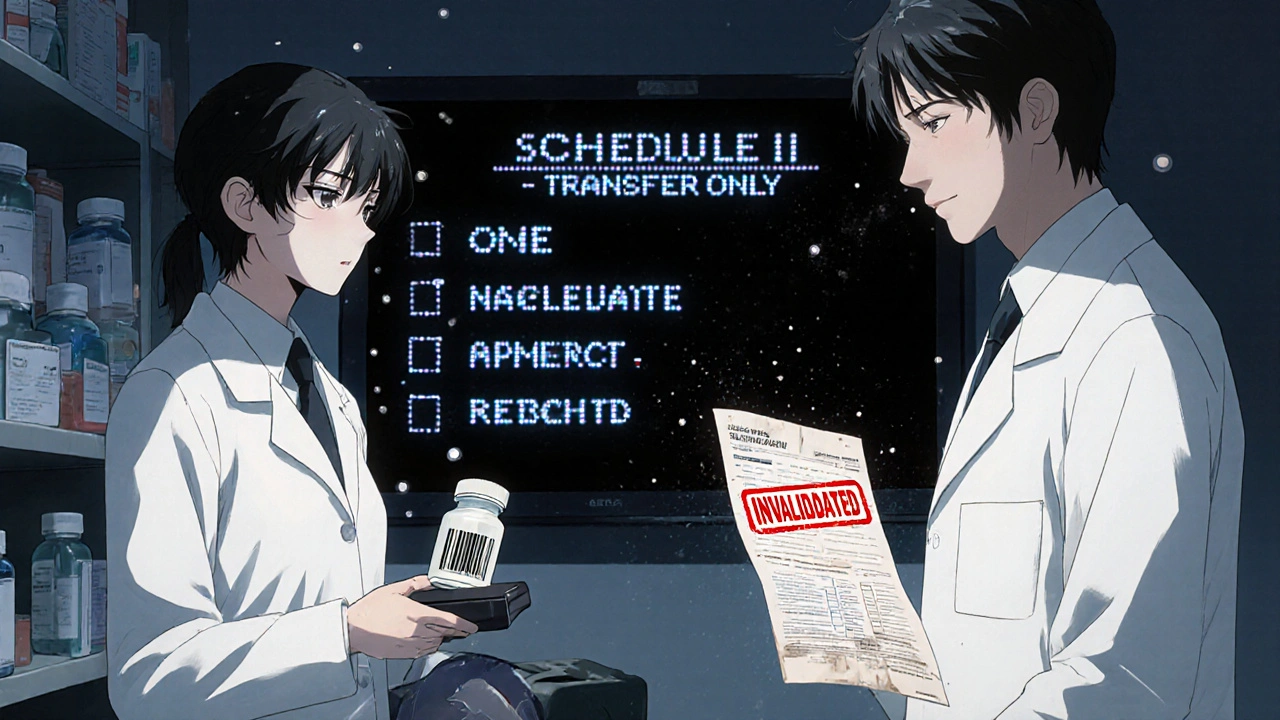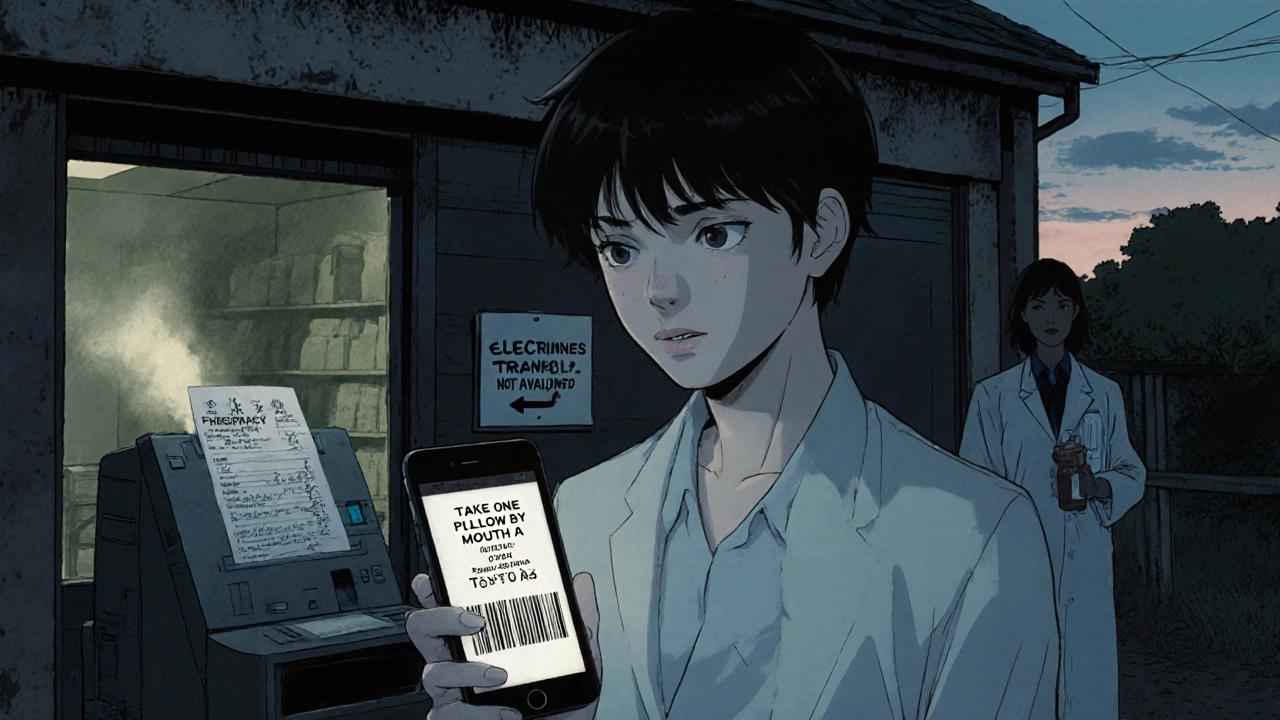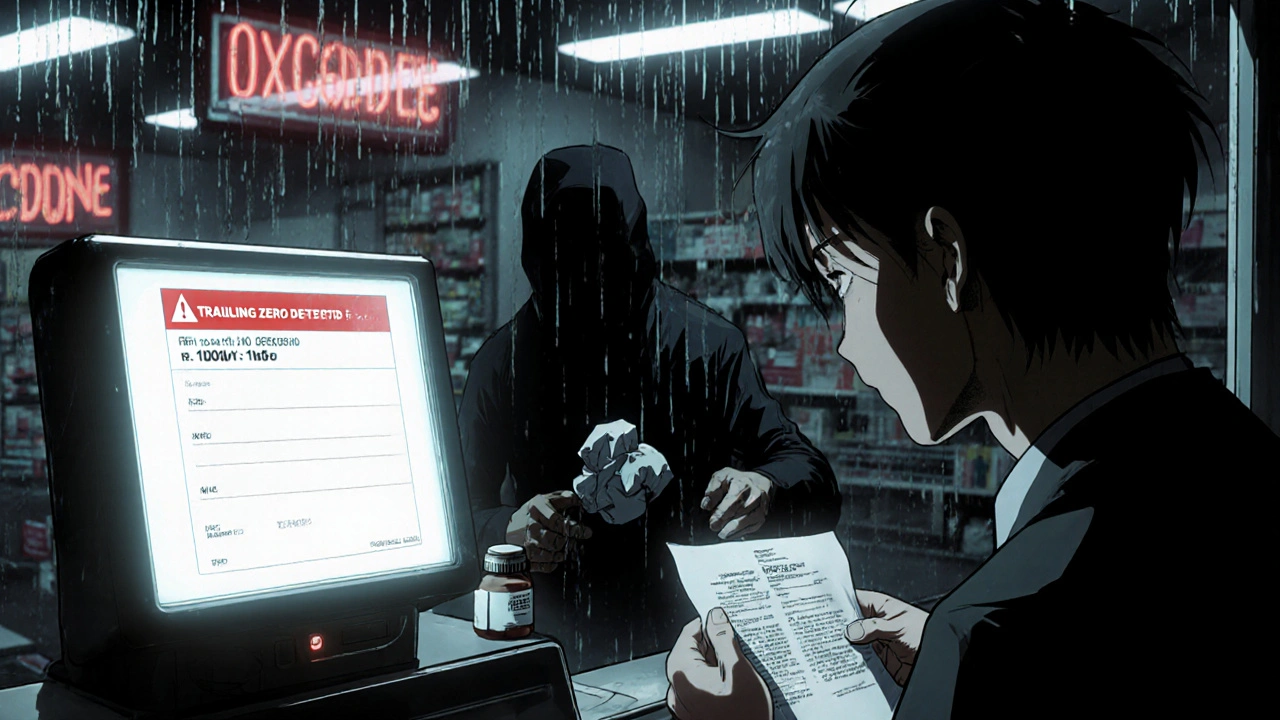Transferring a prescription shouldn’t feel like a game of telephone. One wrong digit, one missing decimal, one misread refill count-and you could be giving someone the wrong dose of medication. In 2025, with electronic systems and strict federal rules, there’s no excuse for avoidable errors. But they still happen. And the consequences? They can be deadly.
Why Prescription Label Accuracy Matters More Than You Think
Every year in the U.S., about 1.5 million adverse drug events are linked to labeling mistakes, according to the FDA. That’s not a small number. It’s not a statistic you ignore. It’s someone’s parent, sibling, or neighbor who got the wrong pill because a label said ‘1.0 mg’ instead of ‘1 mg.’ That trailing zero? It’s not harmless. It’s a known trigger for ten-fold dosing errors. The NCCMERP found that in over 2,300 medication error reports, this tiny mistake showed up again and again.
And it’s not just about decimals. The FDA requires all drug strengths to be written in metric units-grams, milligrams, milliliters-not old-fashioned apothecary terms like ‘grains’ or ‘minims.’ Why? Because mixing systems causes confusion. A 2021 ASHP study showed 12% of dosage errors came from this kind of mismatch. Even something as simple as writing ‘HCTZ’ instead of ‘hydrochlorothiazide’ can lead to a pharmacist pulling the wrong drug off the shelf.
Labels must include: patient name, drug name, strength, dosage form, quantity, directions, prescriber name, prescription number, issue date, refill count, and pharmacy contact info. No exceptions. No shortcuts. And if you’re transferring a prescription, every single one of those fields must carry over-exactly as-is.
The DEA’s 2023 Rule: What Changed for Controlled Substances
Before August 28, 2023, you couldn’t electronically transfer a Schedule II prescription-like oxycodone or fentanyl-between pharmacies at all. That meant if you moved towns or switched pharmacies, you had to get a new paper script from your doctor. It was inefficient. And dangerous. People would skip doses or go without because the system didn’t work.
The DEA changed that. Now, you can transfer Schedule II prescriptions electronically, but only once. That’s it. No second transfers. No refills carried over unless the original prescription had them-and even then, only up to the number left. Schedule III to V drugs (like codeine or anabolic steroids) can be transferred multiple times, as long as refills remain.
Here’s what the transfer record must include:
- The word “transferred” clearly marked
- Name and DEA number of the pharmacy sending it
- Name and DEA number of the pharmacy receiving it
- Date of original prescription
- Date of transfer
- Name of the pharmacist who sent it
- Name of the pharmacist who received it
- Original refill count and remaining refills
- Date of first fill
And here’s the catch: you can’t convert it to a fax, email, or phone call for Schedule II. It has to be a direct electronic transfer using the NCPDP SCRIPT 2017071 standard. Anything else? Invalid. The DEA issued 142 warning letters to pharmacies in 2022 for violating this rule. Most were for trying to bypass the system.
How Electronic Transfers Beat Fax and Phone (And Why They’re Required)
Faxing a prescription? It’s slow. It’s messy. It’s error-prone.
A 2022 University of Florida study found electronic transfers using NCPDP standards had a 98.7% data integrity rate. Fax transfers? Only 82.3%. Phone transfers? Just 76.1%. That’s a 22-point gap between the best and worst methods. And when you’re dealing with something like insulin or warfarin, that gap can kill.
Electronic systems don’t just send data-they validate it. They check:
- Is the patient name spelled the same on both ends?
- Is the strength written as ‘0.4 mg’ and not ‘.4 mg’?
- Are trailing zeros removed?
- Are all refills accounted for?
Many modern pharmacy systems now auto-flag mismatches before the prescription is filled. One pharmacy in Ohio reported a 41% drop in dispensing errors after adding barcode scanning to their transfer workflow. That’s not luck. That’s technology doing its job.
But here’s the problem: not every pharmacy has it. Rural pharmacies? Only 41% are connected to electronic transfer networks, according to the National Rural Health Association. That means patients in those areas still rely on fax or phone-and those methods are still legal for Schedule III-V drugs. But they’re risky. And if you’re transferring a Schedule II, you’re breaking the law if you don’t go electronic.

What Patients Need to Do (Yes, You Have a Role Too)
Too many people think transferring a prescription is the pharmacy’s job. It’s not. You have to start it.
Before you ask your old pharmacy to send your script to a new one:
- Call the new pharmacy first. Ask: “Can you fill this prescription?”
- Confirm they have your drug in stock.
- Ask how many refills they’ll be able to transfer.
- Don’t assume they’ll get it right. If it’s a Schedule II, they can only fill it once. If you don’t confirm availability, you might go days without your medication.
California’s Board of Pharmacy found that 23% of transfer attempts failed in 2022-just because patients didn’t check with the new pharmacy first. One Reddit user shared how they transferred a Schedule II oxycodone script, only to find out the new pharmacy didn’t carry it. They waited five days. Pain returned. They ended up in the ER.
And don’t forget: you have to give your new pharmacy the original prescription number and the name of your prescriber. If you don’t know it, call your doctor’s office. Don’t guess.
What Pharmacists Must Do to Avoid Violations
Pharmacists are on the front line. One missed step, one unverified refill, one truncated label-and they’re on the hook.
The DEA requires transferring pharmacists to:
- Mark the original prescription as “transferred” in the system
- Record the name, address, and DEA number of the receiving pharmacy
- Log the date and their own name
Receiving pharmacists must:
- Add “transfer” to the electronic record
- Include the original pharmacy’s name and DEA number
- Verify all data matches before dispensing
Wisconsin’s rules go further: they require the receiving pharmacist to write the transfer details on the back of the invalidated paper prescription-even if it was sent electronically. That’s extra. But it’s legal. And it protects the pharmacy.
Training matters. Pharmacists need about 8.5 hours of training to get 95% compliant with the 2023 DEA rule, according to the American Pharmacists Association. But turnover is high. The average pharmacy has to retrain staff every 6.2 months because systems update. That’s why double-checking is non-negotiable.
ASHP recommends a two-person verification system for every transfer: one pharmacist enters the data, another reviews it. Add barcode scanning. Do it every time. It’s not extra work-it’s your shield.

The Future: Patient Medication Information (PMI) Rule Coming in 2025
By 2025, the FDA’s new Patient Medication Information (PMI) rule will change everything. Labels won’t just be accurate-they’ll be designed for people, not just pharmacists.
Here’s what’s coming:
- Paper labels become the default. Electronic delivery is optional, but only if the patient asks for it.
- Labels must use plain language: “Take one pill by mouth twice a day” instead of “1 tab po bid.”
- Automated scanners will check for trailing zeros, missing refills, wrong drug names, and illegible handwriting before the bottle leaves the counter.
- Barcodes will link to digital instructions patients can scan with their phone.
Early adopters say it’s expensive-$12,500 to $18,750 per pharmacy location-but worth it. Epic and Cerner are already partnering with major chains to connect pharmacy systems directly to electronic health records. That means when your doctor updates your meds, your pharmacy gets it instantly. No transfers needed. No mistakes.
By 2030, the FDA predicts 40% more prescriptions will contain multiple drugs. Complex regimens. High-risk meds. The margin for error is shrinking. The system has to get smarter. And it’s getting there.
What to Do If Your Transfer Fails
It happens. Systems glitch. Pharmacies don’t talk to each other. You get a call saying your transfer was rejected.
Don’t panic. Do this:
- Ask the receiving pharmacy for the exact reason. Was it a missing DEA number? A trailing zero? A mismatched name?
- Call your prescriber’s office. Ask them to reissue the prescription with the correct details.
- If it’s a Schedule II, you’ll need a new script. No exceptions.
- Keep a copy of the original prescription. Even if it’s electronic, screenshot or print the details.
- If the pharmacy refuses to help, contact your state’s pharmacy board. They can intervene.
And if you’re a patient who’s been without meds for days? Talk to your doctor. Ask for a short-term supply. Many will give you a 3- to 5-day emergency script while the transfer is sorted.
Bottom Line: Accuracy Isn’t Optional
Prescription transfers aren’t just paperwork. They’re safety checks. Every decimal, every refill, every name on that label matters. The rules are clear. The tech exists. The risks are real.
Patients: don’t assume. Confirm. Call ahead.
Pharmacists: verify twice. Use the system. Don’t cut corners.
The system is getting better. But it only works if everyone does their part. Because in this game, the only thing more dangerous than a mistake is thinking it won’t happen to you.


Peter Stephen .O
November 18, 2025 AT 03:51Man, I used to think transferring scripts was just paperwork until my grandma almost got double her insulin dose because of a trailing zero. That one dot saved her life. Now I call every new pharmacy before I even leave the house. Don't be that person who waits till midnight to find out your oxycodone won't transfer. Call ahead. It's that simple.
And yeah, the tech works. My local pharmacy in Ohio added barcode scanning and now they catch errors before the bottle even leaves the counter. No more guesswork. Just science.
Stop treating prescriptions like a game of telephone. This ain't 1998. We got computers for a reason.
Andrew Cairney
November 19, 2025 AT 11:27EVERYTHING is being controlled by Big Pharma and the DEA. You think they care about your safety? Nah. They want you dependent. That ‘one-time transfer’ rule for Schedule II? That’s a trap. They’re forcing you to keep going back to the same pharmacy so they can track you. And don’t get me started on the ‘PMI rule’ in 2025 - plain language? That’s just the first step to dumbing down medicine so you don’t question anything.
They’re using ‘accuracy’ as a cover to control the flow. I’ve seen it. I’ve seen the logs. They’re not fixing errors - they’re creating new ones so you keep coming back.
And why do you think rural pharmacies still use fax? Because the big chains bought out the tech. They don’t want you to have options. 😡
Roberta Colombin
November 21, 2025 AT 11:20Thank you for writing this. As a nurse who has seen too many patients confused by medication labels, I appreciate the clarity.
Many elderly patients don’t understand medical jargon. ‘Take one by mouth twice daily’ is so much clearer than ‘1 tab po bid.’ The FDA’s new rule is long overdue.
Patients need to be partners in this. Don’t be afraid to ask your pharmacist to explain it again. And if you’re unsure, ask for a printed copy - even if you have a phone. Safety shouldn’t depend on tech access.
Small steps matter. Every decimal. Every refill. Every name. We owe it to each other to get it right.
Dave Feland
November 22, 2025 AT 23:52Let’s be precise. The NCPDP SCRIPT 2017071 standard is not ‘a standard’ - it is THE standard. Any deviation, including faxing or emailing a Schedule II, is a federal violation under 21 CFR §1306.25. The DEA’s 142 warning letters in 2022 were not ‘warnings’ - they were documented evidence of willful negligence.
And the ‘trailing zero’ issue? It’s not a ‘mistake.’ It’s a failure to adhere to USP Chapter <795> guidelines on pharmaceutical compounding and labeling. This isn’t opinion - it’s codified law.
Anyone who claims ‘it’s just a typo’ is either dangerously ignorant or deliberately misleading. There is no such thing as a ‘minor’ error in medication labeling. Not in this system. Not anymore.
George Gaitara
November 24, 2025 AT 13:55Okay but have you ever tried transferring a script in rural Alabama? My cousin had to drive 90 minutes because the pharmacy ‘didn’t have the system.’ Meanwhile, the guy at the counter was typing the prescription into a 2010 Dell laptop with a broken keyboard. And you want me to trust ‘electronic transfer’?
And don’t even get me started on the ‘two-person verification’ rule. One guy was texting his girlfriend while the other was napping. They ‘verified’ it. Then the wrong drug got filled.
This whole thing is a joke. The system is broken. The people running it are overworked. And the patients? We’re just the collateral damage.
Also, why is the DEA so obsessed with Schedule II? I’ve seen people get benzos transferred 12 times. But if you need pain meds? Suddenly it’s a federal case. Double standard much?
Deepali Singh
November 25, 2025 AT 00:56India has no such system. We still use handwritten scripts. Sometimes the doctor writes ‘5 mg’ but the pharmacist reads it as ‘50 mg.’ No one checks. No one cares. People die. But here, at least there’s a rule. Maybe that’s something.
I read your post. It’s detailed. Good. But in places like mine, ‘accuracy’ is a luxury. We need infrastructure first. Not more rules.
Sylvia Clarke
November 26, 2025 AT 00:44Oh, so now we’re supposed to be ‘partners’ in our own safety? Cute. Let me get this straight - I’m supposed to call the new pharmacy to confirm they carry my drug, check the refill count, verify the prescriber’s name, and then wait for them to ‘validate’ the transfer… while I’m in pain, on a 10-hour waitlist, and my insurance just denied the copay?
And you wonder why people hoard pills? Because the system is designed to make you suffer before you get help.
‘Accuracy’ sounds noble. But it’s just another way to make patients jump through hoops while pharmacists get paid more for ‘verification.’
Meanwhile, the real problem? The drug companies jack up prices so high that people skip doses. That’s the real killer. Not a trailing zero. Not a fax. The cost. Always the cost.
Jennifer Howard
November 26, 2025 AT 15:05I’ve been doing this for 27 years. I’ve seen it all. And let me tell you - if you don’t write ‘milligrams’ in full, you’re a danger to society. And if you don’t double-check the DEA number? You’re not just sloppy - you’re negligent. And if you think ‘.4 mg’ is okay? That’s not just wrong - that’s criminal. I’ve reported three pharmacists this year alone. One of them was my own nephew. I didn’t care. He almost killed someone.
And don’t even get me started on patients who don’t know their own prescription number. You can’t just say ‘I take the blue pill.’ That’s not a prescription. That’s a fantasy.
My pharmacy uses barcode scanners, two-person checks, and we print out a paper copy for every transfer - even if it’s electronic. Because if the system fails, the paper is your last line of defense. And if you don’t do it? You’re not a pharmacist. You’re a lottery ticket.
Abdul Mubeen
November 27, 2025 AT 12:32Interesting. But why is the DEA allowing electronic transfers at all? In the UK, we still require original paper prescriptions for controlled substances. No exceptions. No transfers. No digital loopholes. It’s simpler. Safer. Less room for hacking, system errors, or rogue pharmacists.
And yet here, we’re embracing digital complexity while ignoring the fact that 41% of rural pharmacies can’t even maintain a stable internet connection. This isn’t progress. It’s overreach wrapped in tech jargon.
Perhaps the real solution is to reduce the number of controlled substances prescribed in the first place - not make the transfer system more complicated.